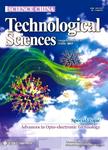Generation of electricity from CO_2 mineralization: Principle and realization
Generation of electricity from CO_2 mineralization: Principle and realization作者机构:Center of CO2 Mineralization and CCUS Sichuan University College of Water Resource & Hydropower Sichuan University Institute for Nanobiomedical Technology and Membrane Biology Regenerative Medicine Research Center West China HospitalWest China Medical School Sichuan University State Key Laboratory of Biotherapy/Collaborative Innovation Center of Biotherapy Wets China Hospital Sichuan University College of Chemical Engineering Sichuan University
出 版 物:《Science China(Technological Sciences)》 (中国科学(技术科学英文版))
年 卷 期:2014年第57卷第12期
页 面:2335-2346页
核心收录:
基 金:supported by the National Natural Science Foundation of China(Grant Nos.51254002 and 21336004) the National Basic Research Program of China(Grant No.2013BAC12B03)
主 题:CO2 mineralization electricity generation sodium bicarbonates CO2 utilization
摘 要:Current CO2 reduction and utilization technologies suffer from high energy consuming. Thus, an energy favourable route is in urgent demanding. CO2 mineralization is theoretically an energy releasing process for CO2 reduction and utilization, but an approach to recovery this energy has so far remained elusive. For the first time, here we proposed the principle of harvesting electrical energy directly from CO2 mineralization, and realized an energy output strategz1 for CO2 utilization and reduction via a CO2-mineralization fuel cell (CMFC) system. In this system CO2 and industrial alkaline wastes were used as feedstock, and industrial valuable NaHCO3 was produced concomitantly during the electricity generation. The highest power density of this system reached 5.5 W/m2, higher than many microbial fuel cells. The maximum open circuit voltage reached 0.452 V. Moreo- ver, this system was demonstrated viable to low concentration CO2 (10%) and other carhonation process. Thus, the existing of an energy-generating and environmentally friendly strategy to utilize CO2 as a supplement to the current scenario of CO2 emis- sion control has been demonstrated.



